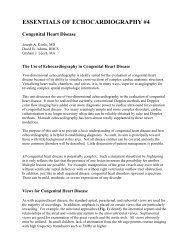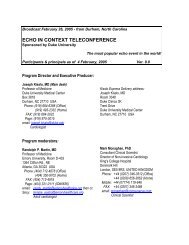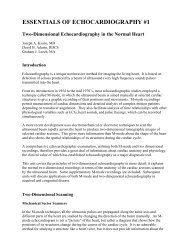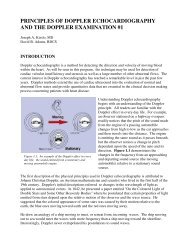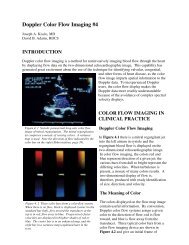doppler evaluation of valvular stenosis #3 - Echo in Context
doppler evaluation of valvular stenosis #3 - Echo in Context
doppler evaluation of valvular stenosis #3 - Echo in Context
You also want an ePaper? Increase the reach of your titles
YUMPU automatically turns print PDFs into web optimized ePapers that Google loves.
Figure 3. 5 <strong>Echo</strong>-Doppler estimates <strong>of</strong> flow volume are<br />
based upon a knowledge <strong>of</strong> the area <strong>of</strong> flow (from<br />
echocardiogram) and the length (from Doppler). It is<br />
assumed that the aorta is a cyl<strong>in</strong>der.<br />
a lower peak velocity (and small flow velocity<br />
<strong>in</strong>tegral) <strong>in</strong> comparison with the flow recorded<br />
through the smaller orifice. The flow velocity<br />
<strong>in</strong>tegral reflects the average velocity <strong>of</strong> the red<br />
cells dur<strong>in</strong>g systole. Because the red cells are<br />
mov<strong>in</strong>g faster through the smaller cyl<strong>in</strong>der,<br />
they travel farther. Thus, the Doppler<br />
record<strong>in</strong>g <strong>of</strong> velocity relates to distance<br />
traveled.<br />
Conceptually, derivation <strong>of</strong> cardiac output<br />
beg<strong>in</strong>s with the recognition that the volume <strong>of</strong><br />
blood ejected every time the heart beats is first<br />
limited by the area <strong>of</strong> the aortic root (the area<br />
<strong>of</strong> the cyl<strong>in</strong>der). While there rema<strong>in</strong>s some<br />
argument as to the precise po<strong>in</strong>t where this area<br />
is best determ<strong>in</strong>ed from the two-dimensional echocardiographic image, most Doppler users<br />
measure the narrowest diameter <strong>in</strong> systole at the bases <strong>of</strong> the aortic valve cusps. This is most<br />
reliably accomplished us<strong>in</strong>g the parasternal<br />
long-axis view. Divid<strong>in</strong>g the diameter <strong>in</strong> half<br />
then results <strong>in</strong> the radius <strong>of</strong> the open aortic<br />
valve. This area is assumed to be a circle and<br />
is determ<strong>in</strong>ed by the standard plane geometric<br />
equation: area = r 2 .<br />
Secondly, the distance the ejected blood travels<br />
may be calculated from the Doppler spectral<br />
record<strong>in</strong>g. S<strong>in</strong>ce this is a measure <strong>of</strong> velocity<br />
over time, the flow velocity <strong>in</strong>tegral will result<br />
<strong>in</strong> the average velocity dur<strong>in</strong>g systole.<br />
Figure 3. 6 When stroke volumes are equal and areas<br />
remarkably different, the resultant velocities <strong>of</strong> flow<br />
may be quite different. The velocity for large areas<br />
would be less than for small areas.<br />
As a result <strong>of</strong> know<strong>in</strong>g the average velocity, his<br />
may be normalized for one second and is an<br />
<strong>in</strong>dex <strong>of</strong> how far the blood has traveled. The<br />
method for calculation <strong>of</strong> cardiac output is<br />
demonstrated <strong>in</strong> Figure 3.7.<br />
It is important to recognize that for proper calculation <strong>of</strong> cardiac output us<strong>in</strong>g this approach the<br />
beam must be as parallel to flow as possible.<br />
Alterations <strong>of</strong> a few degrees from parallel will<br />
result <strong>in</strong> lower Doppler velocity record<strong>in</strong>gs and<br />
underestimation <strong>of</strong> cardiac output. Therefore,<br />
aortic outflow is best obta<strong>in</strong>ed from the apical<br />
or suprasternal approaches where the beam is<br />
nearly parallel to normal flow.<br />
Figure 3. 7 Illustration <strong>of</strong> all the steps required for the<br />
calculation <strong>of</strong> cardiac output by Doppler.<br />
It is also important to remember that the<br />
Doppler estimate <strong>of</strong> cardiac output is based on<br />
the square <strong>of</strong> the measured radius <strong>of</strong> the aorta.<br />
Any error <strong>in</strong> this measurement will be<br />
multiplied and may pr<strong>of</strong>oundly affect the<br />
result<strong>in</strong>g calculation.



